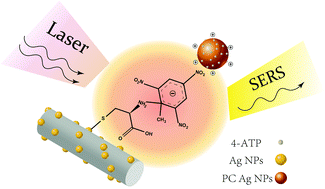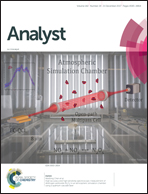Electrospun flexible poly(bisphenol A carbonate) nanofibers decorated with Ag nanoparticles as effective 3D SERS substrates for trace TNT detection†
Abstract
A flexible 3D hybrid PC/Ag surface-enhanced Raman scattering (SERS) substrate was fabricated through the combination of electrospinning and in situ chemical reduction. Due to the rough surface morphology and the intricate 3D structure, a high density of Raman “hotspots” was formed at the junctions of cross-linked nanofibers, resulting in excellent sensitivity to a probe molecule (4-aminothiophenol). The nanofibers were modified with L-cysteine to capture TNT molecules by the formation of a Meisenheimer complex, after which positively charged 4-ATP-labelled AgNPs were introduced to the system, which both generated more hotspots and led to a linear relationship between the TNT concentration and the SERS intensity of the labelled molecules. As a result, a good linear response ranging from 10−8 to 10−12 M was achieved, and the detection limit for TNT was as low as 2.05 × 10−13 M. This strategy demonstrates an ultra-sensitive approach for the detection of trace amounts of TNT, and a promising method for the detection of many other analogous explosives.



 Please wait while we load your content...
Please wait while we load your content...